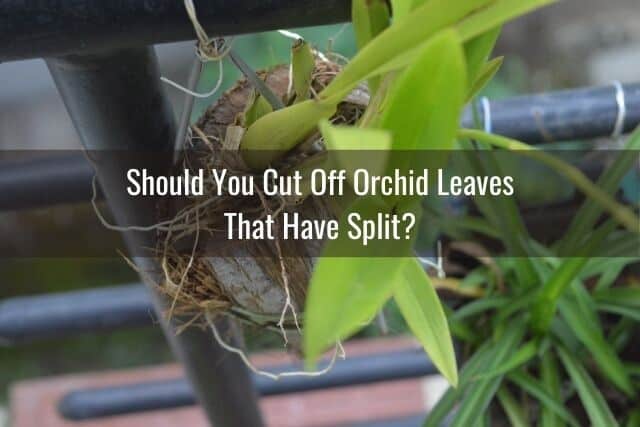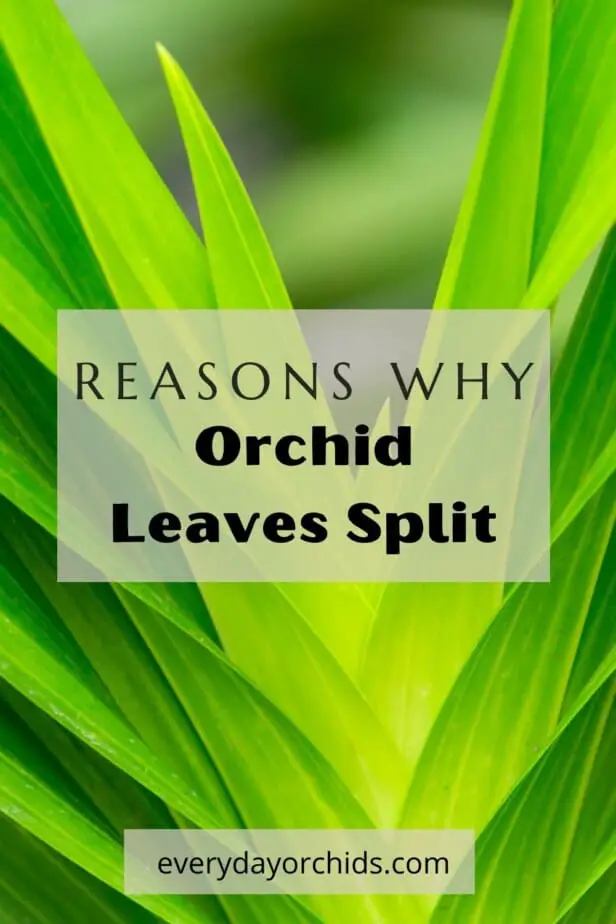Growing orchids is a fun hobby, but sometimes, orchid growers can come across problems, such as when orchid leaves split. These cracks and splits in the leaf are irreversible and can mar the beauty of the plant. This can happen for a number of reasons, some of which are preventable, if you know what to watch out for. Keep reading to learn more.
Your orchid leaves can split due to certain factors. These factors include overwatering, irregular watering, excessive sunlight exposure, or physical trauma to the orchid plant. Sometimes even healthy orchids that receive the best care possible can get split leaves.

It can be alarming when you see your orchid leaves begin cracking and splits start appearing down the middle of the leaf. In this article, I’ll go over how you can spot ailing orchids. I’ll also give you ways to manage orchid leaf split and prevent orchid leaves from splitting in the first place.
Please note that these links are affiliate links and as an Amazon Associate, I earn from qualifying purchases. Purchases made through affiliate links in this post may generate commissions at no additional cost to you. Use this link for a discounted Amazon Prime trial. Thank you for your support!
Table of Contents
Why Do Orchid Leaves Split?

There are a wide variety of reasons that orchid leaves may split. First off, I want to be clear, split orchid leaves are not necessarily due to negligence or sickness. Sometimes a perfectly healthy plant will have split leaves.
In these cases, split or cracked orchid leaves are nothing to worry about. However, before you determine this to be the case, make sure that the leaf splitting is not due to anything related to the surrounding environment or the way you care for your orchids.
Inconsistent Watering and Orchid Leaf Split
Inconsistent watering is one of the top causes of orchid leaves splitting and cracking. It is also one of the most easily preventable ones. Phalaenopsis orchids, in particular, are prone to leaf splitting when erratically watered.
When the orchid does not receive enough water, the leaves begin to wilt and become wrinkled. Watering the orchid after it has already started to wilt will cause leaf splitting.
When the orchid absorbs the water, it will distribute the water to the leaves. This influx of water makes the plant assume its normal shape. However, this rapid influx of water can also sometimes make the leaves split down the vein in the middle. This is because the vein is the weakest part of the leaf and prone to splitting.
Can You Kill Orchids From Overwatering?
Yes, you can kill orchids by overwatering. Too much or too little water have similar detrimental effects. This can lead to leaves splitting, plants wilting, or even the whole plant dying.
Root rot is an unfortunate consequence of overwatering in orchids. You should always carefully monitor the exact amount of water your plant receives. By doing so, you will be able to make sure it stays healthy.
Low Humidity
Low humidity levels are another common cause of orchid leaves splitting. Orchids need humidity in order to grow and thrive. If the air around your orchid plant is too dry, it can cause the leaves to crack or split down the middle.
You can measure humidity using a hygrometer. Most orchids do well with a humidity level between 40-70%. Do your best to keep your orchid’s growing environment in this humidity range.
If you live in an area with low humidity, consider investing in a cool-mist humidifier for your orchids. You can also use a humidity tray or employ other methods of humidifying the air around your orchid. Doing so will minimize the chances your orchid leaves will split along the vein.
Too Much Direct Sunlight

Too much direct sunlight can lead to sunburn, dried out orchid leaves, and orchid leaves splitting or cracking. Orchids, particularly Phalaenopsis orchids, need a balance of bright, but indirect sunlight. Left by a window with direct sunlight, orchids may start showing signs of sun damage within weeks, or even days.
Once the leaf structure is damaged in this way, it is often irreversible. A sunburned leaf may have white, brown, or black dried patches in the areas of sunburn. These dried out areas leave the orchid leaf weak and prone to cracking and splitting.
Watch your orchid’s leaf color. Normal leaf color is grassy green. If your orchid leaves are turning yellow, this could mean that the plant is in the beginning stages of receiving too much sunlight.
Before further damage occurs, you can take proactive measures and remove your orchid from this area. Relocate it to another area where the orchid will receive less light or indirect sunlight. You can also use a sheer curtain to cover the window, reducing the amount of direct sunlight on the orchid.
Physical Trauma
Even if your orchid has the right amount of light and water, the leaves could split or crack for other reasons.
Some of these reasons include trauma or damage from wild animals, such as squirrels and deer. These animals have been known to knock over or bite orchid plants left outside. Even your pets may decide that your orchid is a bit of tasty foliage and bite on the leaf.
The vein in the middle of orchid leaves is the weakest point of the leaf. Unfortunately, it can split easily when direct force is applied.
Sometimes children, especially younger ones, may accidentally pull on or knock over the plant. If the orchid falls and lands on its leaves, the vein in the middle can end up cracked or split.
To prevent this, place your orchids in high, out-of-reach locations. Put your orchid collection where children or animals will be less likely to run into and knock over your plants.
You can also place a safety gate around your orchids. You can keep the door to your orchid room closed. This way, pets will not be tempted to enter and damage your plants.
If the orchids are outside full-time, you can protect your plants by placing a barrier around them. You can use something like chicken wire, a small fence around your outdoor garden, or keep the plants in an enclosed building such as a greenhouse.
Your Plant Already Had Split Leaves
It is also possible that your orchid’s leaves were split or cracked before you acuired. The orchid might have been watered irregularly or damaged in the store. It could have been damaged during transit or packaged too tightly next to another orchid. Any one of these scenarios could have led the orchid leaf to break or split.
When buying your orchid, always inspect the leaves for any cracking and splitting. Do this as part of your routine inspection before you buy your new orchid.
You will also want to look at the roots, blooms, flower spikes, and general condition of the orchid. If the orchid appears otherwise healthy and pest-free, it is fine to purchase the orchid, even if it has a split or cracked leaf.
What is the Difference Between Vertical vs. Horizontal Split in Orchid Leaves?

Generally speaking, a horizontal split or cracked leaf is the result of physical trauma. Orchid leaves do not split horizontally because of natural causes. It is more likely that a child or animal has caused unintentional harm to the plant. If the orchid falls heavily on one side and lands on a leaf, this can cause horizontal leaf split.
Vertical splits are far more common than horizontal splits. That is because they are largely caused by some of the natural causes of splitting, as detailed above.
If you are having more vertical than horizontal splits, it likely means that your orchid needs changes in the way you care orchids. You may need to adjust your watering practices and provide more or less sunlight or humidity.
Keep in mind that even healthy orchid leaves can split despite your best efforts. Cracked or split leaves in healthy orchids should not be a cause for concern.
Should You Cut Off Orchid Leaves That Have Split?

When an orchid leaf splits, this is a permanent change in the structure of the leaf. Unfortunately, the damage is irreversible. The leaf will not be able to mend itself back together, nor is there anything you can do to fix it. Your only options are to remove the affected leaf or to simply live with it. I will review the pros and cons of each option.
Merits of Removing Split Leaves
Keep in mind that any time an orchid leaf has an open split, that area has the potential to be invaded by bacteria. It can become diseased and spread the disease to the rest of the plant. This would be one reason why you might opt to remove the split orchid leaf from your plant.
Another popular reason for cutting off the damaged leaves is that they don’t look good. From a purely aesthetic standpoint, split leaves are like a blemish on the orchid plant. Some orchid growers prefer to remove these imperfections from the plant rather than leave them on.
Whatever your reason is for wanting to cut the leaves off, you will need to use a sterilized x-acto knife. These blades are designed for precision. It will allow you to make a clean cut near the base of the leaf.
For best results, sterilize the blade to reduce the risk of infection. After cutting off the leaf, apply ground cinnamon powder to the cut area on the orchid plant. This will help dry up and seal off the open area and prevent infection.
My Orchid Leaves Are Changing Color, Should I Be Concerned?

Any time that your orchid’s leaves change color, you should closely inspect your plant and its growing environment. Orchid leaves can turn brown, yellow, or even red with too much sunlight. If you catch this early enough, you can stop the leaves from becoming damaged.
An orchid’s leaves turning a darker green color is a sign that it is not getting enough light. In that case, you can simply move the plant to a sunnier locale.
Check out this Everyday Orchids article for an in-depth look at why orchid leaves change color. You can also learn how to address problems in your orchid related to leaf color changes.
Final Thoughts
It can be concerning for your orchid’s naturally beautiful appearance to change due to its leaves splitting and cracking. Still, it is pretty easy to spot the causes and prevent them in the future.
If the leaf split is horizontal or across the leaf, that means the orchid has experienced some physical trauma. If the split is vertical or down the length of the leaf, it could be due to irregular watering, low humidity levels and excessive light exposure. If you do not have problems with watering, sun, or humidity, it is possible your orchids plant simply splits leaves. In this case, there is nothing to worry about.
Knowing how to address leaf split in your orchid is important. It will help you better care for your orchids when these situations arise. Hope the information found in this article helps you!
If you enjoyed this article, please pin it and share!




